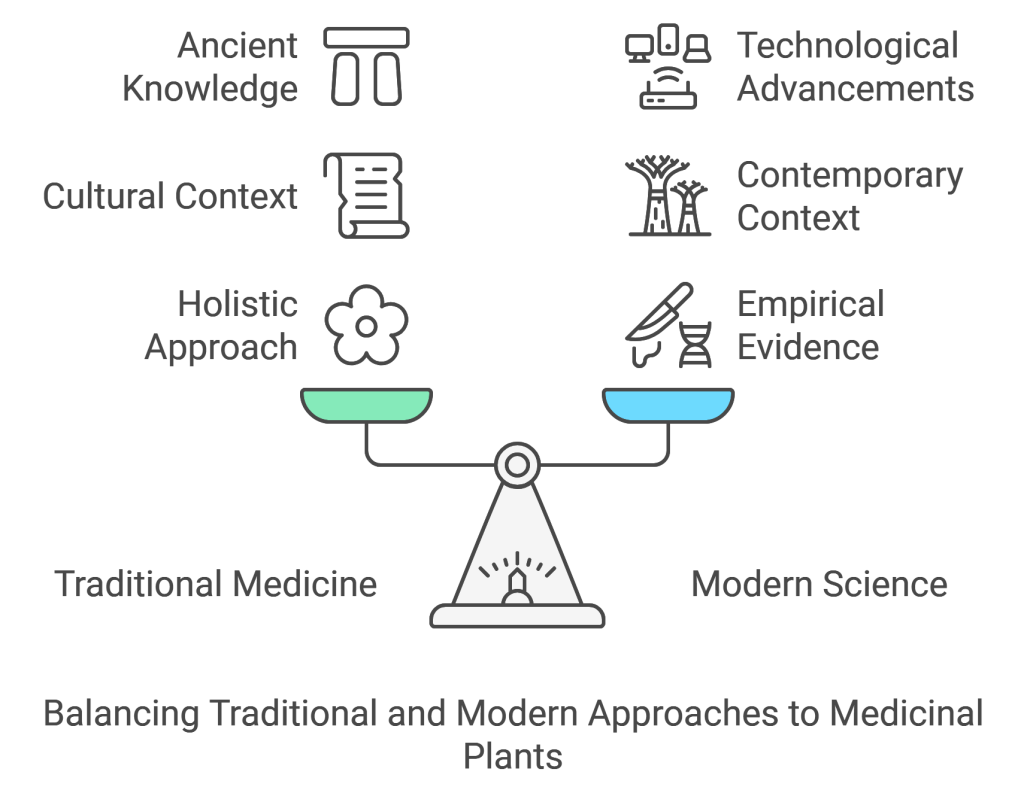Ayurveda and Medicinal Plants: Exploring Traditional Indian Medicine and Modern Scientific Research

Over 170 WHO Member States have reported the widespread use of traditional medicine. This shows the lasting importance of ancient healing practices, like Ayurveda in India. As you explore Ayurveda and medicinal plants, you’ll see a blend of old wisdom and new science. This blend offers a holistic way to improve your health.
Ayurveda, an ancient Indian medicine system, is known for its deep understanding of the body, mind, and spirit. It uses nature’s power, thanks to a wide range of medicinal plants. This creates a perfect mix of old knowledge and new science. Plants like ashwagandha and turmeric can change your health and wellness.

Discover the deep wisdom of Ayurveda and how to use it every day. Learn about the three doshas – Vata, Pitta, and Kapha. Find out how Ayurvedic healing has lasted for centuries. Join us as we explore the history of traditional Indian medicine, from ancient texts to herbal formulas passed down through generations.
Understanding the Ancient Wisdom of Ayurvedic Medicine
Ayurvedic medicine comes from ancient India and focuses on the whole person. It looks at the body, mind, and spirit together. This approach is known for treating serious diseases like cancer.
It’s based on the three doshas: Vata, Pitta, and Kapha. Each person has a mix of these energies that affect how they feel and act.
The Three Doshas: Vata, Pitta, and Kapha
Every person has a special mix of the three doshas. Vata is about air and space, controlling movement and talking. Pitta is fire and water, handling how we digest and metabolize. Kapha is earth and water, keeping us stable and lubricated.
Basic Principles of Ayurvedic Healing
Ayurvedic medicine aims to bring balance to the body, mind, and spirit. It uses Ayurvedic herbs, special diets, and therapies to fix imbalances. This way, it helps the body heal itself and stay healthy.
If you want to feel better or tackle a health issue, Ayurvedic medicine is worth trying. It’s all about holistic healing and traditional Ayurvedic treatments. Learning about it can help you take charge of your health.
Ayurveda and Medicinal Plants: A Comprehensive Guide
Ayurveda, an ancient Indian holistic medicine, values medicinal plants highly. These Ayurvedic herbs and therapeutic plants are key to Ayurvedic phytotherapy and botanical medicine. They offer natural remedies for many health issues.
Ayurvedic medicine focuses on balance between three energies: Vata, Pitta, and Kapha. Each energy affects our health differently. Practitioners use Ayurvedic herbs to balance these energies.
Herbs like ashwagandha soothe, while ginger energizes. The Ayurvedic collection is vast, with many health benefits. These botanical medicines are mixed to treat specific issues and help the body heal.
Looking for stress relief, better digestion, or more energy? Ayurveda’s medicinal plants provide a holistic solution. Discover the wisdom of Ayurveda and the power of Ayurvedic herbs.
Historical Evolution of Traditional Indian Medicine
Ayurveda, the traditional Indian medicine, has deep roots that go back thousands of years. Ancient texts and medical manuscripts are the base of this holistic healing system. The Charaka-samhita is from the 1st century CE, but earlier versions existed.
The Sushruta-samhita is from the last centuries BCE and was fully formed by the 7th century CE. These texts show the vast knowledge of Ayurvedic practitioners.
 “I’m Alive” by Céline Dion: The Technology That Keeps Music Timeless
“I’m Alive” by Céline Dion: The Technology That Keeps Music Timeless
Ancient Texts and Medical Manuscripts
These ancient texts documented the knowledge of Ayurvedic practitioners. For example, the Sushruta-samhita listed 1,120 diseases. Charaka recognized 500 medicinal plants, showing the wide scope of traditional Indian medicine.
The Development of Herbal Formulations
Botanical drugs were key in Ayurvedic treatments. Sushruta knew 760 plant-based remedies. Over time, Ayurvedic practitioners developed many herbal formulations to treat various health issues.
Knowledge Transfer Through Generations
The passing down of Ayurvedic knowledge was vital. Practitioners shared their expertise, techniques, and herbal recipes with future generations. This ensured the tradition’s growth and survival.
Exploring the history of traditional Indian medicine shows Ayurveda’s adaptability. It has evolved over centuries, using ancient wisdom and the knowledge of many practitioners.
Essential Ayurvedic Herbs and Their Therapeutic Properties
Ayurvedic medicine, an ancient Indian healing system, values medicinal plants highly. These Ayurvedic herbs have been used for centuries to improve health and treat many ailments. We will look at some key therapeutic plants in Ayurveda and their amazing natural remedies.
Ashwagandha (Withania somnifera) is a key herb in Ayurvedic phytotherapy. It’s known for reducing stress and boosting energy. It also supports the immune system, brain function, and sleep.
- Turmeric (Curcuma longa) is famous for its anti-inflammatory and antioxidant powers. It helps with arthritis, digestion, and some cancers.
- Ginger (Zingiber officinale) is versatile and helps with digestion, nausea, and muscle soreness.
- Brahmi (Bacopa monnieri) enhances brain function, improving memory and concentration.
| Ayurvedic Herb | Therapeutic Properties | Potential Applications |
|---|---|---|
| Ashwagandha | Adaptogenic, Stress-relieving, Rejuvenating | Immune function, Cognitive performance, Sleep |
| Turmeric | Anti-inflammatory, Antioxidant | Arthritis, Digestive issues, Cancer |
| Ginger | Digestive aid, Anti-nausea, Anti-inflammatory | Digestion, Nausea, Respiratory issues, Muscle soreness |
| Brahmi | Cognitive-enhancing, Neuroprotective | Memory, Concentration, Brain health |
These herbs have been used for centuries to improve health. Modern science is now backing their benefits. This is making Ayurvedic natural remedies more popular in healthcare.
Modern Scientific Research Supporting Ayurvedic Practices
Ayurvedic medicine is gaining worldwide recognition. Scientific research is backing up its effectiveness. Studies are showing how Ayurvedic practices can work well with modern medicine.
Clinical Studies and Evidence-based Research
Many studies have shown Ayurvedic herbal remedies work well. For example, saffron supplements helped patients with ulcerative colitis feel better. It also kills colon cancer cells in lab tests and helps with eye health.
This research supports the ancient wisdom of Ayurveda. It shows that traditional medicine is backed by science. As more research comes out, Ayurvedic medicine will fit better into modern healthcare.
Integration with Contemporary Medicine
Scientific research, evidence-based Ayurveda, and clinical studies are pushing for integrative medicine. This mix of old and new treatments offers a more complete healthcare approach.
The South Asian American community is growing in the U.S. This means Ayurvedic practices will have more influence. Brands are already celebrating Diwali and working with South Asian founders to connect with the community.
Combining Ayurvedic wisdom with modern science is a big chance for better healthcare. It lets doctors give patients more effective treatments. This can greatly improve people’s health and well-being.
Preparing and Using Ayurvedic Herbal Remedies
Ayurvedic medicine is an ancient Indian system of holistic healing. It focuses on the power of medicinal plants and herbs. If you’re interested in Ayurvedic herbal remedies, there are several ways to prepare and use them.
 Barranquilla Carnival: Colombia’s Most Spectacular Cultural Celebration
Barranquilla Carnival: Colombia’s Most Spectacular Cultural Celebration
One way is to make Ayurvedic decoctions. This involves boiling herbs in water to extract their compounds. To do this, add herbs to water, boil, then simmer for 15-20 minutes. Strain the liquid and enjoy it as a tea or tonic.
Another option is Ayurvedic infusions. Here, herbs are steeped in hot water for 5-10 minutes. This method is gentler and preserves the plants’ delicate compounds. You can try different herbal medicine combinations for various health concerns.
For external use, Ayurvedic botanical preparations like oils and balms are great. These are made by infusing herbs in a carrier oil like coconut or sesame. They can be used for massage, topical application, or in baths.
It’s crucial to follow the right dosage and storage for Ayurvedic natural remedies. Always consult with an Ayurvedic practitioner or health professional. This ensures safe and effective use of the remedies.
By embracing Ayurveda’s ancient wisdom, you can unlock nature’s healing gifts. Incorporating these herbal remedies into your wellness routine can be transformative.
The Role of Botanicals in Holistic Healing
In Ayurveda, botanicals have always been key to healing. They work together to help with many health problems and improve overall well-being. Today, science is learning more about their benefits, making Ayurveda and modern medicine work together.
Synergistic Effects of Plant Compounds
Ayurvedic experts know that plants work better together. This is why they mix different plants in their remedies. This mix creates a powerful treatment that tackles health problems at their source.
Sustainable Harvesting Practices
Keeping medicinal plants safe is very important in Ayurveda. It’s vital to harvest them in a way that doesn’t harm the environment. Ayurvedic practitioners work with local people to make sure plants are gathered responsibly. This shows their respect for nature and helps Ayurvedic medicine last for the future.
| Botanical | Therapeutic Properties | Sustainable Harvesting Practices |
|---|---|---|
| Ashwagandha | Adaptogenic, anti-inflammatory, and neuroprotective | Cultivated in designated organic farms, with strict regulations on harvesting techniques and plant preservation |
| Turmeric | Anti-inflammatory, antioxidant, and antimicrobial | Grown using traditional methods that promote soil health and biodiversity, with a focus on sustainable rhizome division |
| Ginger | Digestive, anti-nausea, and anti-inflammatory | Intercropped with other plants to maintain soil fertility, with careful monitoring of harvesting cycles |
By using Ayurvedic medicine and plants in a sustainable way, we can fully benefit from these natural remedies. This helps us live in harmony with our ecosystems and improves our health.
Common Ailments and Their Ayurvedic Treatment Approaches
Ayurveda is an ancient Indian healing system. It uses medicinal plants and herbs to balance the body. This approach helps promote long-term well-being.
Looking for Ayurvedic treatments, natural remedies, or herbal medicine? This section offers insights into holistic healing.
Ayurveda focuses on your unique constitution, or “doshas.” Understanding your dosha helps tailor treatments. Ayurveda addresses many health issues, from digestive problems to mental health challenges.
Herbs like bhumyamalaki, kutki, and kalmegh are key in Ayurvedic medicine. They protect the liver, detoxify, and reduce inflammation. Using Ayurvedic treatments and holistic healing can boost your body’s healing power.
 Why is the Mona Lisa Called the Gioconda?Unraveling the Mystery Behind Two Names
Why is the Mona Lisa Called the Gioconda?Unraveling the Mystery Behind Two Names






